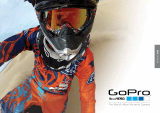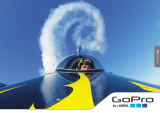
To combine cameras in 3D HERO System waterproof housing:
1. Open back door to the 3D housing.
2. Insert “right” camera right side up into housing.
3. Insert “le” camera upside down into housing.
4. I
nsert the 3D HERO Sync Cable into the HERO Bus
Port on both cameras. The side that says “R” on the
sync cable attaches to the right camera while side that
says “L” on the sync cable attaches to the le camera.
Note: Upon insertion of the sync cable, the right
camera will automatically set itself to be in UP mode
and the le camera will automatically set itself to
be in UPd mode. This configuration is required for
capturing synchronized 3D videos and photos. If 3D
synchronization is not desired, you can manually
change each camera’s settings to be in a different
UP/UPd mode, different resolution, etc, but the
cameras will only record in a synchronized manner
allowing for 3D if BOTH cameras are set to shoot the
same resolution, record mode and frame rate.
5. Make sure the 3D Sync Cable is fully inserted
and is flush against the back of the cameras.
Close waterhousing.
If settings are changed and you wish to return each camera
to its default 3D setting, simply unplug the sync cable and
then plug the sync cable back in to both cameras. This will
reset the right camera to UP mode (right side up) and the le
camera to UPd mode (upside down), allowing for synchronized
3D video and photo capture.
REMOVING 3D SYNC CABLE FROM CAMERAS
To remove the sync cable from the HD HERO Bus Port, grasp
each 3D sync port connector firmly and remove by liing
device evenly away from the HERO Bus Port. Do NOT pull on
cable connecting the le and right HERO port connectors.
5













